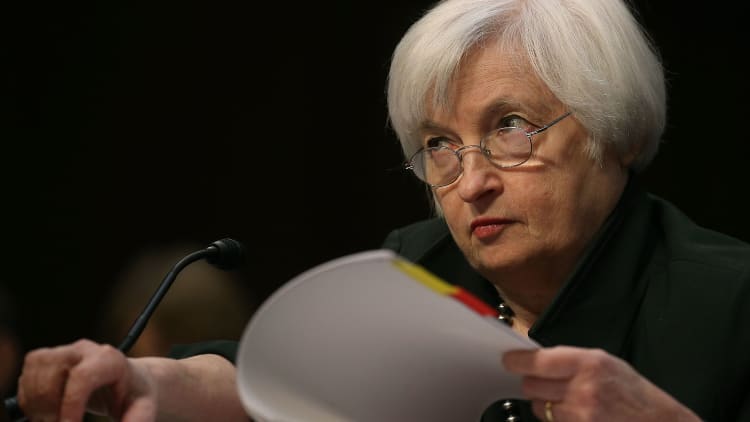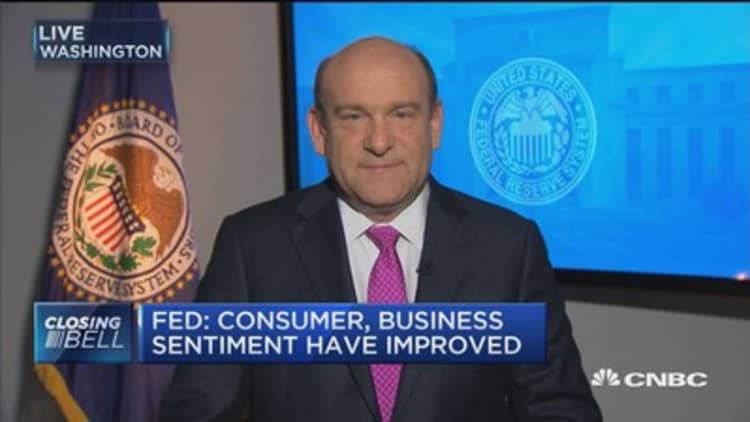
The Federal Reserve held the line on interest rates at its meeting this week, though it did give a nod to growing optimism among the business community and consumers.
As widely expected, the Federal Open Market Committee — the central bank's policy making arm — kept its benchmark overnight lending rate target at a range of 0.5 percent to 0.75 percent. In December, the Fed raised the target a quarter point, or 25 basis points, marking just the second hike in more than 10 years.
There was little in the post-meeting communique to indicate when the Fed might resume the rate normalization process.
However, officials did take note of a change in mood.
"Measures of consumer and business sentiment have improved of late," the committee said Wednesday. The language was new, and in the arcane process of discerning where the thinking resides among central bankers, it was significant.
Wall Street indeed has shown more optimism in the days since Donald Trump scored an upset in the November presidential election. Stocks have rallied, and measures of business, investor and consumer sentiment have been strong.
"There's been this dichotomy that's occurred since the election between measures of sentiment and real activity. There's been this real animal spirits story," said Mark Doms, senior economist and managing director at Nomura. "One of the things the Fed is going to be looking for, as well as the market, is whether these animal spirits are going to materialize in a meaningful way."
Trump has pledged a program of lower taxes, reduced regulations and higher government spending on infrastructure to goose a slow-growing economy.
For years, the Fed has encouraged more fiscal stimulus to complement its historically aggressive monetary policy.
In addition to its observations on sentiment, the FOMC removed a reference to the effect that declining energy prices have had on inflation. Oil prices have moved higher, albeit in an occasionally volatile manner, and are not having the same depressing impact on inflation.
"They are still in a wait and see mode," said Joseph LaVorgna, chief U.S. economist for Deutsche Bank. "This is a Fed that's still going to be very cautious and gradual in raising rates and will be reactive. They are not going to be moving in an anticipatory sense."
The Fed also did not alter the closely watched risks outlook to its economic projections. The statement again gauged near-term risks to "appear roughly balanced," meaning there is an equal chance of the economy exceeding or falling short of FOMC members' estimates.
The committee also gave no indication on when it may start unwinding its $4.5 trillion balance sheet, a topic of increasing interest on Wall Street lately.
The Fed has a 2 percent target for inflation that has been difficult to achieve in the post-recession climate, despite the central bank holding rates low and expanding its balance sheet.
Looking at the economy, the committee said growth is expanding at a "moderate" pace while the labor market "has continued to strengthen."
"Job gains remained solid and the unemployment rate stayed near its recent low," the statement said, reflecting just a minor tweak from language at the December meeting.
The FOMC meeting came the same day as a report indicating that job growth may in fact be even stronger than the Fed anticipates.
Private payrolls grew by 246,000 jobs in January, according to ADP and Moody's Analytics. The number far eclipsed market expectations and perhaps served as an indicator of still more slack in the labor market.
The Fed statement, as usual, said its policy will support "some further strengthening" in the jobs picture as well as an expected return to 2 percent inflation.
Though the statement repeated that monetary policy remains "accommodative," Fed officials in December indicated that three more rate hikes are on the way in 2017. Market expectations are for a somewhat less aggressive Fed, with just two hikes, in June and December, currently priced in.



